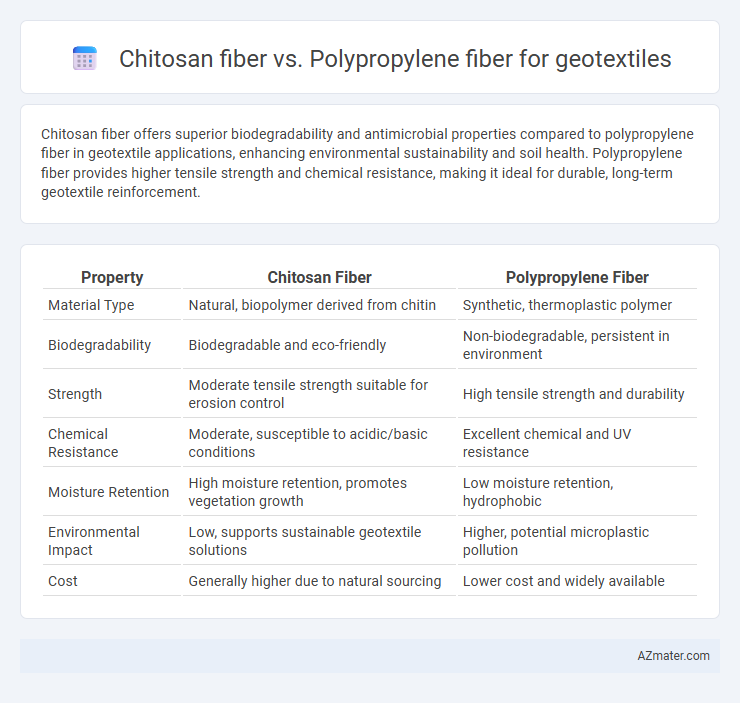Chitosan fiber offers superior biodegradability and antimicrobial properties compared to polypropylene fiber in geotextile applications, enhancing environmental sustainability and soil health. Polypropylene fiber provides higher tensile strength and chemical resistance, making it ideal for durable, long-term geotextile reinforcement.
Table of Comparison
| Property | Chitosan Fiber | Polypropylene Fiber |
|---|---|---|
| Material Type | Natural, biopolymer derived from chitin | Synthetic, thermoplastic polymer |
| Biodegradability | Biodegradable and eco-friendly | Non-biodegradable, persistent in environment |
| Strength | Moderate tensile strength suitable for erosion control | High tensile strength and durability |
| Chemical Resistance | Moderate, susceptible to acidic/basic conditions | Excellent chemical and UV resistance |
| Moisture Retention | High moisture retention, promotes vegetation growth | Low moisture retention, hydrophobic |
| Environmental Impact | Low, supports sustainable geotextile solutions | Higher, potential microplastic pollution |
| Cost | Generally higher due to natural sourcing | Lower cost and widely available |
Introduction to Geotextile Fibers
Geotextile fibers such as Chitosan and Polypropylene are essential in soil reinforcement, erosion control, and filtration applications. Chitosan fiber, derived from natural biopolymers, offers biodegradability, excellent tensile strength, and antimicrobial properties, enhancing environmental compatibility. Polypropylene fiber, a synthetic polymer, provides superior durability, chemical resistance, and cost-effectiveness, making it widely used in long-term geotextile installations.
Overview of Chitosan Fiber
Chitosan fiber, derived from chitin found in crustacean shells, exhibits excellent biodegradability and antimicrobial properties, making it an eco-friendly alternative in geotextile applications. Its unique molecular structure enhances soil stabilization and water retention, promoting sustainable land reclamation and erosion control. Compared to polypropylene fiber, chitosan fiber offers superior environmental compatibility while maintaining adequate tensile strength for geotechnical use.
Overview of Polypropylene Fiber
Polypropylene fiber is widely used in geotextiles due to its high tensile strength, chemical resistance, and durability under harsh environmental conditions. Its hydrophobic nature prevents water absorption, ensuring long-term stability and resistance to microbial degradation. Compared to chitosan fiber, polypropylene offers superior mechanical properties and cost-effectiveness for large-scale geotechnical applications.
Mechanical Properties Comparison
Chitosan fiber exhibits superior tensile strength and elongation compared to polypropylene fiber, offering enhanced flexibility and durability in geotextile applications. The biodegradability of chitosan allows for environmentally sustainable performance, whereas polypropylene maintains high abrasion resistance and chemical stability. Mechanical testing reveals chitosan fibers provide better load-bearing capacity, while polypropylene fibers excel in resistance to UV degradation and long-term structural integrity.
Biodegradability and Environmental Impact
Chitosan fiber, derived from natural sources like crustacean shells, offers superior biodegradability compared to polypropylene fiber, which is petroleum-based and non-biodegradable. The biodegradation of chitosan reduces long-term environmental pollution and enhances soil health by facilitating microbial activity, whereas polypropylene fibers persist in the environment, contributing to microplastic contamination. Using chitosan fiber in geotextiles supports sustainable construction practices by minimizing ecological footprints and promoting eco-friendly disposal options.
Chemical Resistance and Durability
Chitosan fibers exhibit high chemical resistance due to their natural biopolymeric structure, making them effective in acidic and saline environments commonly encountered in geotextile applications. Polypropylene fibers demonstrate excellent durability and resistance to a wide range of chemicals, including alkalis, acids, and solvents, which contributes to their widespread use in long-term geotextiles. While polypropylene offers superior durability in harsh chemical conditions, chitosan fibers provide eco-friendly alternatives with notable biodegradability and moderate chemical resistance.
Cost Analysis and Availability
Chitosan fiber for geotextile applications generally incurs higher production costs due to its bio-based extraction process and limited commercial scale, whereas polypropylene fiber benefits from established mass production methods, significantly lowering its price point. Availability of polypropylene fiber is widespread globally, supported by robust supply chains and extensive manufacturing facilities, making it readily accessible for large-scale geotextile projects. Chitosan fiber's market availability remains niche and regionally constrained, often impacting its feasibility for cost-sensitive or high-volume geotextile applications.
Performance in Geotechnical Applications
Chitosan fiber offers superior biodegradability and environmental compatibility compared to polypropylene fiber, making it ideal for sustainable geotextile applications. Its natural antimicrobial properties enhance soil stabilization and erosion control, while polypropylene fibers provide higher tensile strength and durability for heavy load-bearing geotechnical projects. Performance in geotechnical applications depends on project requirements: chitosan fibers excel in ecological sensitivity, whereas polypropylene fibers dominate in mechanical resilience and longevity.
Installation and Handling Considerations
Chitosan fiber in geotextiles offers enhanced biodegradability and antimicrobial properties, but requires careful handling due to its sensitivity to moisture and UV exposure during installation. Polypropylene fiber provides superior durability and chemical resistance, allowing for easier installation in harsh environments with less concern for degradation or fiber damage. Proper storage and installation techniques must be adapted for chitosan fibers to prevent premature deterioration, whereas polypropylene fibers are more forgiving and user-friendly in diverse conditions.
Future Trends and Innovations in Geotextile Fibers
Chitosan fiber, derived from chitin, offers biodegradable and antimicrobial properties increasingly favored in sustainable geotextile applications, contrasting with polypropylene fiber's established durability and cost-effectiveness. Future trends emphasize enhancing performance through bio-based composites and smart fiber technologies incorporating sensors for real-time monitoring of soil conditions. Innovations also target improving chitosan fiber's mechanical strength and environmental resistance to compete with synthetic fibers in large-scale infrastructure projects.

Infographic: Chitosan fiber vs Polypropylene fiber for Geotextile
 azmater.com
azmater.com